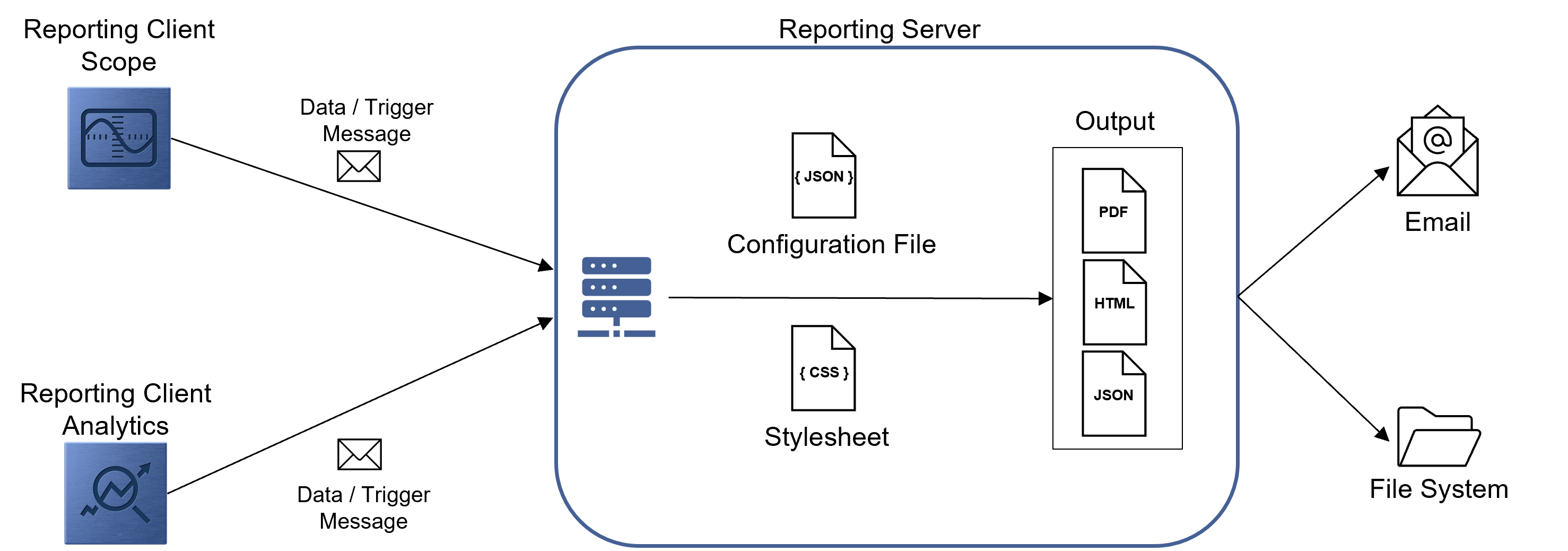Basic concept
The following figure shows the basic concept of TwinCAT Reporting from the Reporting Clients to the distribution of the generated Reports.

Reporting Clients
Currently, a Reporting Client is integrated in the TwinCAT Scope View as well as in the TwinCAT Analytics Workbench or in the TwinCAT Analytics Service Tool. These tools provide the ability to implement 24/7 reporting and on-demand reporting.
- Scope Reporting
- Analytics Reporting
24/7 reporting is also possible via the PLC. The function blocks have the same functionality as the algorithms from TwinCAT Analytics.
- PLC Reporting
The Reporting Clients communicate with the TwinCAT Reporting Server. The Reporting Clients can send two types of messages. On the one hand, data messages can be sent with the associated data. On the other hand, so-called trigger messages can be communicated. This type of message triggers the generation of a report.
TwinCAT Reporting Server
The TwinCAT Reporting Server has a variety of tasks. The server receives the messages from the Reporting Clients and stores the data in a DataStore. A report can be defined in an associated configuration file. The assignment of a data object to a report is established via a Report Name and a Data Key. The design of the report in can be customized in a stylesheet. As soon as a trigger message is received, a report with the associated data is generated in the configured formats and distributed accordingly.
Glossary
Term | Explanation |
Report | A report is a document available in PDF, HTML and JSON formats. It contains the information and images. |
Configuration file | The configuration file describes the structure of a report. It also offers the possibility to integrate static information into a report by default. Furthermore, settings can be made in the Reporting Server for the corresponding report. |
Reporting Server | The Reporting Server manages the configuration files, receives information and creates individual reports from this information. |
Reporting Client | A Reporting Client can be used to send data to the Reporting Server or to trigger the creation of a report. |
Data message | A Reporting Client can send information to the Reporting Server via a data message. The contained data is cached in the Reporting Server. |
Trigger message | A Reporting Client can send a trigger message to the Reporting Server, triggering the generation of a report. For this purpose, the Reporting Server uses all data received up to this point and belonging to the corresponding report. After generation, the data is deleted. |
Report Name | The Report Name is used to identify a report. The Report Name is derived from the name of the configuration file without the extension (e.g.: configuration file: Beckhoff Report Template.json; Report Name: Beckhoff Report Template) |
Data Key | A Data Key identifies a data object of a report. It must be unique within a report and its configuration file. This can ensure the assignment and sorting of data objects in the report. |
24/7 Reporting | 24/7 Reporting provides the ability to collect data and automatically generate reports. |
On-demand reporting | On-demand reporting provides the ability to generate custom reports on demand. |